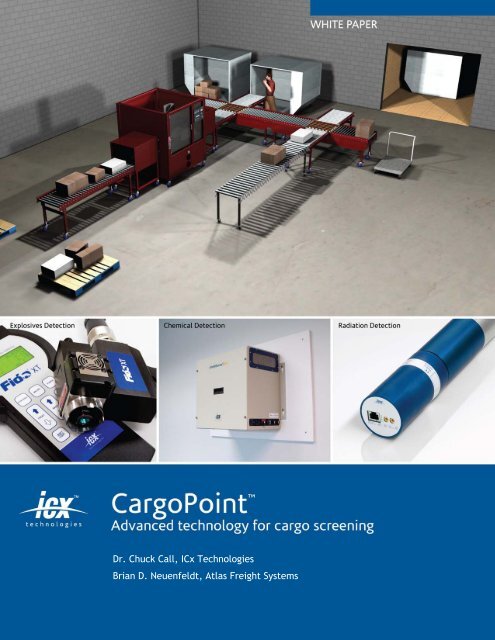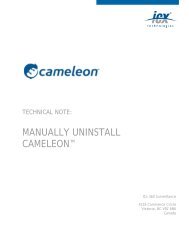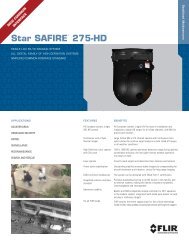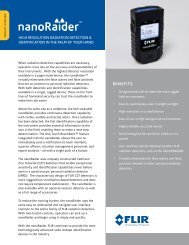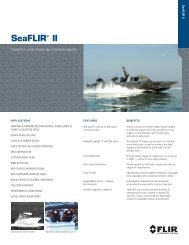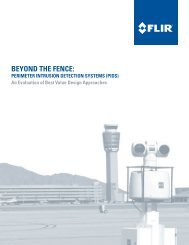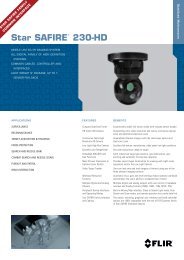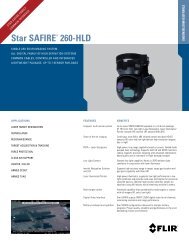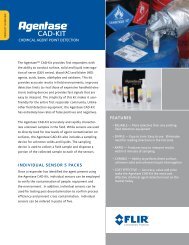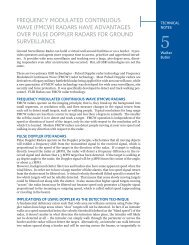Dr. Chuck Call, ICx Technologies Brian D. Neuenfeldt ... - FLIR.com
Dr. Chuck Call, ICx Technologies Brian D. Neuenfeldt ... - FLIR.com
Dr. Chuck Call, ICx Technologies Brian D. Neuenfeldt ... - FLIR.com
- No tags were found...
Create successful ePaper yourself
Turn your PDF publications into a flip-book with our unique Google optimized e-Paper software.
<strong>Dr</strong>. <strong>Chuck</strong> <strong>Call</strong>, <strong>ICx</strong> <strong>Technologies</strong><strong>Brian</strong> D. <strong>Neuenfeldt</strong>, Atlas Freight Systems
Supply chain management represents a significant <strong>com</strong>ponent to national security and anintricate balancing act for the transportation industry. While ensuring that all cargo isdeemed safe, the shipping industry also needs to ensure that cargo moves quickly, withoutclogging the supply chain.The Department of Homeland Security (DHS) is responsible for all air cargo security and seaport security. However, they have delineated the two so that the Transportation SecurityAdministration (TSA) is responsible forair cargo security, while Customs andBorder Patrol (CBP) is responsible for seaport security. Both agencies within DHSrecognize the necessity for cargosecurity and have implemented programsto increase cargo safety and security.Congress has mandated that all air cargoon passenger aircraft be screened byAugust, 2010. In addition, Congress alsomandated that 100% of sea cargo bescreened before it is loaded on a US-bound vessel.In response to these requirements, foreign shipping entities are also looking at reciprocalscreening mandates for cargo entering their nations. As the largest cargo transit hub in theworld, the US supply chain is already taxed. Without significant improvement to security andscreening procedures, these new regulations have the potential to drastically impact the USsupply chain, significantly diminishing supply chain velocity.Any answer to this problem must weigh the strengths of the screening technologies againstthe impact on the supply chain. Accurate, fully automatic cargo screening for boxes andparcels is the only answer. Whether cargo is screened and secured at the point of departureor arrival, it is vital that proper screening methods to be in place to ensure safety.It also makes sense that a single approach to the supply chain security problem beimplemented for the transportation industry and our sea ports. Uniformity across shipping
lanes will increase the speed and accuracy of security measures. By incorporating logisticsautomation technologies, the system can simultaneously offer other value propositions – suchas enhanced in-transit visibility (ITV) – to the supply chain.<strong>ICx</strong> <strong>Technologies</strong> and Atlas Freight Systems are leading the effort toward automated, in-linescreening capabilities for cargo and parcel security. <strong>ICx</strong>, as a leader in chemical, biological,radiological, nuclear and explosives (CBRNE) sensors, is uniquely positioned to provide anarray of field-proven detection equipment for cargo screening.CargoPoint, from <strong>ICx</strong> <strong>Technologies</strong>, provides fast, sensitive screening for explosives, nuclearmaterials, chemical agents and other threatening <strong>com</strong>pounds. The system is a larger versionof the field-tested ParcelPoint which is currently in use in Iraq and utilizes the firstautomated, robotic swipe capability for cargo screening.At <strong>ICx</strong>, we understand the disruptive nature and true cost of false alarms. Our integratedsecurity platforms, such as CargoPoint, meet the needs inherent in today’s transportationsecurity environment. All the sensors and instruments included in a CargoPoint system aredesigned for the environment within which they are intended to be used. As a result,business flows without disruption.CargoPointCargoPoint provides fully automatic cargo screening for boxes and parcels based on theproven capabilities of the ParcelPoint system, but on a larger scale. As an industry-friendlydevice, CargoPoint interfaces with inventoryor warehouse management systems and canfeed automated waybill or manifestgeneration systems. This device is capable ofweighing, cubing and bar code reading parcelswhile it simultaneously screens for radiation,biological and chemical threats – and links allof this information to warehouse managementsystems, inventory management systems,generates air waybills or ocean manifests Figure 1: DOD Prototype CargoPoint system
automatically – and can be upgraded to automatically apply some form of tamper evidence toeach parcel screened. This type of logistics/supply chain security automation technologyshould be acceptable by both TSA and CBP. This is the type of technology that secures thesupply chain without sacrificing supply chain velocity.CargoPoint incorporates the highest sensitivity explosives trace detector (ETD) technologyavailable – the Fido ® . The Fido XT is a proven device with years of reliable operation in bothIraq and Afghanistan. The radiological, chemical and biological agent detection devices arealso in use at high value facilities such as thePentagon. Incorporated into CargoPoint,these technologies provide highly sensitivedetection results while still screening up to300 boxes per hour.CargoPoint is not just a cargoscanning/screening device. This is anautomated information data capture (AIDC)device capable of reading bar codes and Figure 2: Fido® trace explosive detectorsinterfacing with a number of warehouse orembedded in CargoPointinventory management systems. Bar codescans can be linked to the security screening process as well as container ID, vehicle number,GPS antenna number, driver details, RFID tag number, etc. This gives the customer the abilityto drill down to the relevant level of detail that they need. This also provides an interface toa variety of in-transit visibility (ITV) or container security device (CSD) tools. The result ofthis “smart cargo screening” process is improved supply chain security concurrent withenhanced ITV.The cargo-specific variant of ParcelPoint has been termed CargoPoint. When the cargo isscreened, there is an option to automatically apply a tamper evident technology (TET) such astape or labels.CargoPoint incorporates industry-appropriate technology and sustainable business processeswhich include all of the features DHS (TSA and CBP) and DoD USTRANSCOM and internationalshippers should require for supply chain security management. The goal is to institute anautomated cargo screening system that supports all transportation modes – air, land and sea –
and the creation of ISO-28000 <strong>com</strong>pliant supply chains leading into and out of any country inthe world. A focus of this project is to develop a viable and sustainable business model thatdoes not adversely impact industry while fully supporting the security requirementsestablished by DoD and DHS.Atlas is a participant in the TSA Certified Cargo Screening Program technology pilot. Throughinitial evaluation in this pilot program, the <strong>ICx</strong> <strong>Technologies</strong> Fido and CargoPoint are seen asviable candidates for supply chain security management. Fido has been in use by DoD foryears in Iraq, Afghanistan and elsewhere. The transportation industry can leverage this DoDprogram and the TSA’s on-going evaluation to develop secure supply chain solutions that areeasily adopted by industry. Additional benefits of this dual-use technology include:• Integrated approach People – knowledgeable logistics personnel working side-by-side with technologydevelopers and customers Technology – dual-use, developed for DOD and proven on the battlefield Procedures – develop a viable and sustainable business model that does not adverselyimpact industry and supports the security requirements established by DOD and DHS• Business Processes Integration – Data Sharing Shipper data• Commodity• Cost• Country of originIntegrated WITH Consignee data• End user• Country of destination Transportation data• Mode(s) of transport• Pick-up date
• Delivery date• Container number• Container integrity reports• Container location reports• Optional incorporation of tamper evident technology (TET) Integrated Exporters System (IES) interface with IRRIS, Tapestry or BCS3• Warehouse Management• Customs Clearance• Global Track-and-Trace• Manifest and Waybill Generation• Accounting• Leveraged approach Build off DoD investment in Fido®• Proven performance in Iraq and Afghanistan in a physical security and forceprotection role Leverage TSA air cargo screening initiatives Plan for container security and screening requirements in the near future• Dual-use technology Military-to-Commercial Commercial-to-Military DHS Customs Border Protection and Transportation Security Administration solution<strong>com</strong>patible with DoD• Defense-in-Depth• Air cargo screening• Container contents screening (explosive and radiation detection)The original system, ParcelPoint, was developed by DoD to screen US Postal Service mailinbound to service-members stationed overseas. The DoD prototype scans for radiation,weighs and sizes boxes, screens for explosives, uses a mass spectrometer to identify specificisotopes of radiation and finally screens for biological or chemical agents. This system is
developed with discrete modules for CBRNE, and modules can be added or subtracteddepending on the customer’s requirements.The same DoD-developed technology used toscreen for IEDs and for IED-makers is used inCargoPoint. The Fido XT is currentlydeployed to both Iraq and Afghanistan. Thisis a proven technology that has been testedin a battlefield environment.As a fully integrated system, CargoPoint canbe inserted into several points along thesupply chain. At foreign ports, theCargoPoint can be used to meet theFigure 3: CargoPoint system installed inAtlas Freight Systems, Houston, TXCongressional mandate for pre-screening ofcargo loaded onto US-bound vessels. Insidethe US, the system can be used at US Ports to quickly screen cargo, ensuring the contentssafety before moving down stream in the supply chain. The system is versatile enough to beinstituted at initial cargo loading points as well, helping to ensure its swift movement to itsdestination. By validating an item’s security, shippers can help ensure that their cargo is notunduly detained at any point – saving time and money while providing customer satisfaction.


